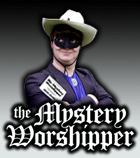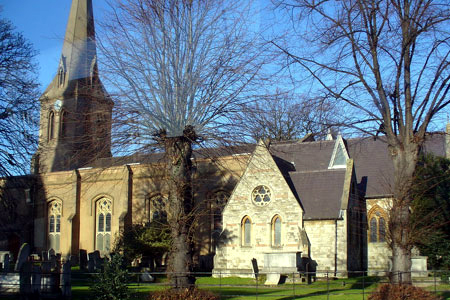| |
 |
 |
 |
| Comment on this report, or find other reports. |
 |
| Our Mystery Worshippers are volunteers who warm church pews for us around the world. If you'd like to become a Mystery Worshipper, start here. |
 |
| Find out how to reproduce this report in your church magazine or website. |
|
|
| 2098: St Leonard's,
Streatham, London |
 |
 Photo: Jeff Warder
Photo: Jeff Warder |
 |
Mystery
Worshipper: Jezebel's Sister.
The church:
St
Leonard's, Streatham, London.
Denomination:
Church
of England, Diocese
of Southwark.
The building:
There has been a church on this site for 1000 years, give or
take. It's the oldest building in Streatham. The current structure
dates from 1350, with a major Victorian renovation. Badly damaged
in 1975 by a fire fanned by a strong wind, the chancel bares
its wounds proudly against stark white walls and a modern roof
and galleries. The east window is new and tells the story of
the church over the centuries, but the body of the church is
striking for its plain unadorned whiteness. It's lovely. There
is a nice modern chapel at the back, with glass walls onto the
nave, and a tiny side chapel in the north aisle with a simple
triptych icon of St Leonard and St Laura, the latter being the
untimely-deceased daughter of a former vicar, if I understood
correctly.
The church:
I think this report demonstrates one huge element of community
involvement, but there are others. It's an inclusive church
with a devotion to Anglican liturgy and music that genuinely
attempts to marry ancient and modern. The congregation span
all generations and many races and set an example that it would
be nice to see some more centrally located churches emulate.
The neighbourhood:
St Leonard's sits at a busy corner on the London to Brighton
road, across the street from an equally impressive Roman Catholic
church, so from a distance they create a double landmark. Streatham
(pronounced Strettam, colloquially called Saint Reetham) is
five miles south of central London and is registered in the
Domesday Book. It used to be well out in the Surrey countryside,
but today it is deep south London (i.e., not the posh part).
Streatham suffers from the south London curse of being off the
Underground map, so it doesn’t get a lot of tourists, but there
are three overground rail stations, and the coming of the railways
caused a massive population boom in the 19th century, and for
a while St Leonard's was actually a fashionable house of worship.
Streatham is now a multicultural community, and that is an understatement.
The church sits at the bottom of a very long hill leading down
from Brixton towards Croydon. The shops and pubs and restaurants
that line both sides of the road in both directions are mostly
small businesses, with only a few of the predictable chains,
and none of the ones that don't move in until the neighbourhood
is gentrified. However, they are all in business – I didn't
notice any boarded-up shops. Germane to this report is the fact
that there are two major prisons nearby (Brixton and Wandsworth)
and that places the church in the catchment area for the recently
released.
The cast:
The Revd Mandy Hodgson, rector, celebrated. Dame Anne Owers,
Her Majesty's Chief Inspector of Prisons, preached. There were
also three assistant priests and a considerable altar party
of acolytes and servers, but I'm afraid these must remain nameless.
The date & time:
Saturday, 6 November 2010, 7.30pm.
What was the name of the service?
St Leonard's Day Eucharist 2010 – the church's patronal festival service.
How full was the building?
Respectably full. There were probably as many empty seats as
full ones, but the people were scattered so there were no huge
gaps, at least in the central aisles. I would estimate about
70 in the congregation, with another 20 or so comprising the
choir and altar party.
Did anyone welcome you personally?
Yes, indeed, but not just to the service. St Leonard is the
patron saint of prisoners, and the church used the occasion
of its patronal festival this year to showcase organisations
working locally and nationally with prisoners and ex-prisoners
and for penal reform. Several of these groups had tables at
the back of the church for an hour before the service, and they
were all very ready to welcome visitors.
Was your pew comfortable?
There are no pews – possibly lost in the fire in 1975 –
and the linked upholstered chairs, in a sad shade of beige,
looked as if they dated from the morning after. Any padding
they may have contained has been compressed over the years,
and I didn't see one that wasn't in dire need of deep cleaning
or reupholstering. They were still fit for purpose and comfortable
enough, but they just made the place look unnecessarily dingy.
There were hooks on the backs of the chairs, but no kneelers,
so no kneeling was done although it was indicated in the service
sheet.
How would you describe
the pre-service atmosphere?
The church was busy, with everyone milling round the prison
groups' displays. Gradually, as the service time approached
and vested people started moving things around, the people took
to their seats and a woman went around ensuring everyone had
service sheets.
What were the exact opening words of the
service?
"Good evening and welcome." This was the signal to get people
to sit down. Then: "In the name of the Father, and of the Son,
and of the Holy Spirit. Amen."
What books did the congregation use during the
service?
There was an order of service specific to the evening, which included a few pages at the front with contact details for all the prison relief organisations taking part in the evening, as well as some that weren't represented, such as the two local actual prisons.
What musical instruments were played?
Organ. According to the website, the present two-manual, tracker-action organ was built by JW Walker & Sons and installed at the west end of the gallery in 1979, the previous Walker organ having been destroyed in the 1975 fire. According to one of the assistant priests, this was one of the fortunate results of the fire. There was also a 10-strong mixed choir.
Did anything distract you?
There was a motion-sensitive light outside one of the windows
on the south side that flashed on and off randomly, as the churchyard
is a well-used local shortcut.
Was the worship stiff-upper-lip,
happy clappy, or what?
The high side of the middle of the road. The service was formal
but warm and engaging, with enthusiastic singing. The very first
thing that happened, during the processional hymn, was the censing
of an icon of St Leonard in a side chapel. There was lots of
incense, and an abundance of vested clergy and robed servers.
The celebrant wore a simple, elegant gold chasuble with a red
lining, while two of the assistant priests wore glorious gold
copes.
Exactly how long was the
sermon?
13 minutes. The sermon was a continuation of the tradition known
as the Howland sermon. Elizabeth Howland (d. 1719), whose memorial
to her husband dominates the church porch, bequeathed a sum
of money for a sermon to be preached annually.
On a scale of 1-10, how
good was the preacher?
9 – Dame Anne was very interesting; she spoke clearly,
knows her subject, and had a strong message. Drawing on her
decade of experience as Chief Inspector of Prisons, she drove
her points home with a voice of authority.
In a nutshell, what was
the sermon about?
In a nutshell, our prisons are a mirror of society at large.
They reflect in their populations our collective issues of family
breakdown, isolation, mental health problems, inequality, and
so on. We need to sort out these problems in the society outside
the prison walls in order to solve and ideally prevent the same
problems inside. Prisoners are the ultimate outsiders in our
society, often before they get locked up. We lock them up out
of sight because we are disturbed and challenged by outsiders.
Even prison officers are not given the same respect as other
public service professionals such as teachers, nurses and the
police. Women in prison often say that the first time they ever
got access to the help they needed was inside, and young people
in prison especially experience life in a parallel universe.
At the time of judgement, we will be called to account for what
we have failed to do to support those members of society who
needed food and drink, clothing, shelter and companionship.
Which part of the service
was like being in heaven?
I really respected that they had used the occasion of their
patronal festival to invite in so many charities and voluntary
groups who work in the area, and that those people stayed for
the service and participated. It was a living demonstration
of a church that is truly striving to engage, and a community
that appreciates that engagement. And a fun moment came at the
end of the service, when the rector presented the preacher with
a bunch of flowers. She explained that the original bequest
for the annual Howland sermon was for a payment of 40 shillings
for the guest speaker, but that only translates to two pounds
in today's money, so she thought a bouquet would be more appropriate!
And which part was like
being in... er... the other place?
I don't mind a light, bright sunny church, but this was a late
autumn evening, and there were literally dozens of very bright
spotlights, giving rather the atmosphere of a fast-food outlet
at night. Dimming the lights and reupholstering the chairs would
do a lot for the aesthetics of the church, in my opinion.
What happened when you hung around after the service looking lost?
During the organ postlude, a convoy of people moved in and loaded
a table with wine and soft drinks and various trays and plates
of savoury treats. The prison charities went back to their tables
and continued to explain their work to people, drinks in hand,
while children circulated with trays of cheese straws and savoury
nibbles. It was very convivial, and a couple of people initiated
conversations with me outside of that context as well. It felt
very welcoming.
How would you describe the after-service
coffee?
This was a festal service, so there was a feast. Wine and juice
and nibbles. I don't know what the normal Sunday fare would
be, but I am sure it would exist and the sense of conviviality
would prevail.
How would you feel about making this church your regular (where 10 = ecstatic, 0 = terminal)?
8 – I enjoyed the evening and the people I met. By the natural light of day, it would suit me very well.
Did the service make you
feel glad to be a Christian?
Yes, it did. The theme of the evening was printed alongside
an image on the service sheet of a prisoner in chains: "I was
a prisoner and..." It was wonderful to see so many doing so
much to live the message of Matthew 25:31-46 – "Whatever
you did for one of the least of these..." Several of the
charities had materials featuring testimonials from the prisoners
and ex-prisoners whose lives had been changed through the charities'
ministries – in practical, not evangelical ways.
What one thing will you
remember about all this in seven days' time?
The prisoners' testimonials. St Leonard would have been pleased. |
|
|
 |
 |
 |
| We rely on voluntary donations to stay online. If you're a regular visitor to Ship of Fools, please consider supporting us. |
 |
 |
 |
| The Mystery Pilgrim |
 |
| One of our most seasoned reporters makes the Camino pilgrimage to Santiago de Compostela in Spain. Read here. |
 |
 |
 |
| London churches |
 |
| Read reports from 70 London churches, visited by a small army of Mystery Worshippers on one single Sunday. Read here. |
| |
|
|
|
|


